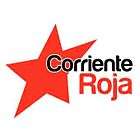Corriente Roja
Corriente Roja | |
|---|---|
 | |
| Catalan name | Corrent Roig |
| Galician name | Corrente Vermella |
| Leader | Ángel Luis Parras |
| Founded | 2002 |
| Headquarters | Madrid |
| Ideology |
Before 2012: Communism Feminism Internationalism Since 2012: Trotskyism |
| Political position | Far-left |
| National affiliation |
United Left (until 2004) None (Since 2004) |
| International | International Workers' League - Fourth International (since 2012) |
| Colors | Red |
| Website | |
| corrienteroja.net | |
Corriente Roja (Red Current or Red Stream in English language. CR) is a Spanish political organization, of communist and, since 2011, trotskyist ideology, adhering to the International Workers League – Fourth International in 2012. CR defends and supports social struggles, class independence and political gains of the working class in order to establish a republic of workers. CR proposes the construction of a socialist economy, based on workers' democracy and the traditions of the alternative labor movement. According to its mission statement, current Red describes itself as follows:
Corriente Roja will put in place an estrategy defined by its anticapitalist Marxist character, radically democratic, internationalist, ecologist and feminist
The organization is present in Madrid, Seville and Catalonia, and has some members in Galiza. In Catalonia Corriente Roja is called Corrent Roig, while in Galiza is called Corrente Vermella.
History
CR was formed as an internal current in United Left (IU) in 2002, characterized by the defense of communist values they thought had been lost in the progressive deideologization of IU. In 2004 the organization left the coalition.
Initially, its members were free to belong to other political parties, part of its membership being until June 2005 affiliated to the Communist Party of Spain (PCE). The most representative figure during this period was the exMP Ángeles Maestro.[1] Currently the organization is part of the International Workers' League - Fourth International (IWL). The majority of those members of the PCE were expelled from the party in 2005 for supporting the Communist Party of the Basque Homelands (PCTV-EHAK) in the Basque elections of that year, and not Ezker Batua-Berdeak, the Basque affiliate of the PCE and IU.
In May 2007 the organization suffered a split in Madrid, that formed Comunistas 3. Comunistas 3 accused the Revolutionary Workers Party - Revolutionary Left (PRT-IR) of trying to control Corriente Roja.
In the 2009 European elections CR supported and participated in Iniciativa Internacionalista (II-SP), a coalition of the Basque Abertzale Left, Izquierda Castellana, Galician People's Front and different anticapitalist parties and organizations of all Spain led by the writer and playwright Alfonso Sastre. II-SP got 178'121 votes (1'15% of the total vote) and no seats in the European Parliament.
In the Catalan elections of 2010 CR supported and joined Des de Baix (From Below in Catalan language). Des de Baix was also supported by Anticapitalist Left, In Struggle and Internationalist Struggle. The coalition gained 7'169 votes (0'23% of the total), failing to gain any seats in the Parliament of Catalonia.[2]
In the summer of 2011, the organization underwent a split, when a part of the original founders accused the PRT-IR, that in April of that year decided to dissolve the party within Corriente Roja, of wanting to turn CR in the Spanish section of the trotskyist International Workers' League - Fourth International in Spain.[3] Ángeles Maestro and the majority of the founder of the organization left CR and formed Red Roja. Corriente Roja officially joined the International Workers' League - Fourth International, adopting Trotskyism as the official ideology of the organization.[4] Corriente Roja adopted, since 2012, very controversial stances on international conflicts, for example, being one of the few left-wing parties in Spain that supported the Syrian rebels or the struggle against Kadafi in Libya.
In the Catalan elections of 2012 Corriente Roja gave the Popular Unity Candidacy (CUP) a critical support.